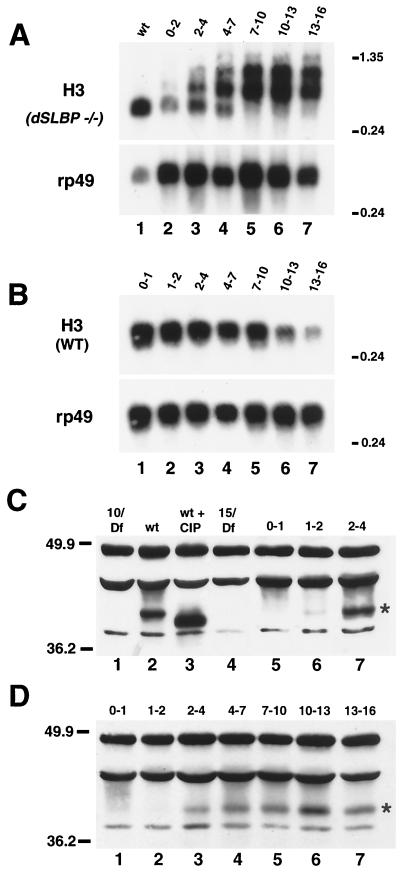FIG. 8.
dSLBP function is required as soon as zygotic transcription begins. Appearance of misprocessed histone mRNA in dSLBP mutant embryos is coincident with the normal onset of dSLBP protein expression. (A) Total RNA from 13- to 16-h-old wild-type embryos (lane 1) and the poly(A)+ RNA fraction from appropriately aged embryos collected from dSLBP15/+ parents corresponding to 0 to 2 h (lane 2), 2 to 4 h (lane 3), 4 to 7 h (lane 4), 7 to 10 h (lane 5), 10 to 13 h (lane 6), and 13 to 16 h (lane 7) AED was subjected to Northern analysis using a radiolabeled H3 coding region probe. Polyadenylated H3 mRNA begins to accumulate at ∼2 h of embryogenesis, which is the time when most zygotic gene expression begins. The blot was stripped and reprobed for rp49 as a loading control. (B) Total RNA isolated from wild-type embryos aged 0 to 1 h (lane 1), 1 to 2 h (lane 2), 2 to 4 h (lane 3), 4 to 7 h (lane 4), 7 to 10 h (lane 5), 10 to 13 h (lane 6), and 13 to 16 h (lane 7) AED was probed with the histone H3 coding region. (C and D) Western analysis of embryonic extracts using affinity-purified anti-dSLBP rabbit antibodies. dSLBP protein is indicated with an asterisk. All other bands represent nonspecific cross-reactingproteins (48). (C) Lane 1, 0- to 2-h-old embryos collected from dSLBP10/Df(3R)3450 females; lane 2, wild-type 13- to 16-h-old embryos; lane 3, wild-type 13- to 16-h-old embryo extract treated with CIP. Note that dSLBP migrates faster after phosphatase treatment. Lane 4, 13- to 16-h-old dSLBP15/Df(3R)3450 embryos. Extracts of wild-type yw67 embryos collected 0 to 1 h (lane 5), 1 to 2 h (lane 6), 2 to 4 h (lane 7) AED. (D) Extracts of wild-type yw67 embryos collected 0 to 1 h (lane 1), 1 to 2 h (lane 2), 2 to 4 h (lane 3), 4 to 7 h (lane 4), 7 to 10 h (lane 5), 10 to 13 h (lane 6), and 13 to 16 h (lane 7) AED. These are the same embryo collections used to prepare the RNA for panel B.

